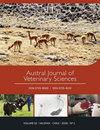Effects of the inclusion of brown seaweed (Macrocystis pyrifera) additive in the diet of grass-fed steers on carcass performance, meat quality, and nutrient composition
IF 0.5
4区 农林科学
Q3 VETERINARY SCIENCES
引用次数: 0
Abstract
. The objective of this study was to evaluate the inclusion of a brown seaweed additive (SWA; Macrocystis pyrifera ) in the diet of grass-fed steers on carcass performance, beef quality, and nutrient composition. A total of 20 Holstein-Friesian steers were randomly distributed into two groups: Control group (a basal diet without supplementation of SWA) and SWA group (2%-SWA) with basal diet + 30 g/day/animal of SWA during the breeding phase (11 months) and 48 g/day/animal of SWA during the fattening phase (4 months). Steers fed with 2%-SWA were not different ( P >0.05) in final body weight, carcass weight, carcass dressing, fat thickness, ribeye area, and marbling score than those from the Control group. Likewise, no effects of 2%-SWA supplementation were detected ( P >0.05) for beef quality traits, glycolytic potential, or their metabolites (muscular glycogen, glycose+glucose-6-phosphate, and lactate), evaluated in longissimus lumborum (LL) samples. Sensory evaluation showed a slight preference for Control group samples rather than those from the 2%-SWA group (58.93% and 41.07%; P =0.06). Regarding, proximal composition, the inclusion of SWA only affected the total lipids present in the LL samples, which decreased significantly ( P =0.01) in LL samples of grass-fed steers fed with 2%-SWA. The composition of macro (Ca, Na, Mg, P, and K) and micro (Mn, Fe, Cu, and Zn) minerals in LL samples were not affected ( P >0.05) by the inclusion of SWA in the diet. The inclusion of the additive based on brown seaweed had not a detrimental effect on carcass performance, beef quality, and mineral content, however, it reduced the total lipids content in the LL muscle.饲粮中添加褐藻添加剂对草饲肉牛胴体性能、肉品质和营养成分的影响
. 本研究的目的是评估褐藻添加剂(SWA;饲粮中添加大囊藻(Macrocystis pyrifera)对草饲肉牛胴体性能、牛肉品质和营养成分的影响。选取20头荷斯泰因-弗里西亚阉牛,随机分为对照组(基础饲粮中不添加SWA)和SWA组(2%-SWA),育成期(11个月)基础饲粮中添加30 g/d SWA,育肥期(4个月)基础饲粮中添加48 g/d SWA。饲粮添加2%-SWA的肉牛末重、胴体重、胴体屠宰、脂肪厚度、肋眼面积和大理石纹评分与对照组相比差异无统计学意义(P < 0.05)。同样,在腰最长肌(LL)样品中,没有检测到添加2%-SWA对牛肉品质性状、糖酵解潜能或其代谢产物(肌糖原、糖糖+葡萄糖-6-磷酸和乳酸)的影响(P < 0.05)。感官评价结果显示,与2%-SWA组相比,对照组样品的偏好略高(58.93%和41.07%);P = 0.06)。在近端组成方面,添加SWA仅影响LL样品中的总脂质,添加2% SWA的草饲肉牛LL样品中总脂质显著降低(P =0.01)。饲粮中添加SWA对LL样品中宏量矿物质(Ca、Na、Mg、P、K)和微量矿物质(Mn、Fe、Cu、Zn)的组成无显著影响(P < 0.05)。褐藻基添加剂的添加对胴体性能、牛肉品质和矿物质含量没有不利影响,但降低了LL肌中总脂质的含量。
本文章由计算机程序翻译,如有差异,请以英文原文为准。
求助全文
约1分钟内获得全文
求助全文
来源期刊

Austral Journal of Veterinary Sciences
Veterinary-General Veterinary
CiteScore
1.60
自引率
0.00%
发文量
18
期刊介绍:
Austral Journal of Veterinary Sciences (formerly Archivos de Medicina Veterinaria) publishes original scientific contributions in English, containing the latest developments and discoveries in veterinary sciences. The journal covers topics such as animal health and production, preventive medicine, zoonosis, pharmacology and therapeutics, methods of diagnosis, and other areas related to the veterinary field.
Austral Journal of Veterinary Sciences aims to divulge information about advances in veterinary medicine among universities, research centres, industries, government agencies, biologists, agronomists and veterinarians.
 求助内容:
求助内容: 应助结果提醒方式:
应助结果提醒方式:


